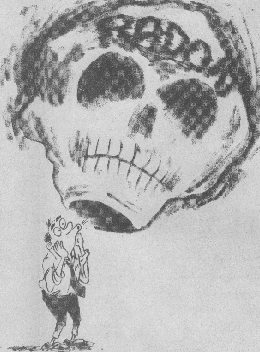Michael Fumento
Factual · Powerful · Original · Iconoclastic
Radon Redux
January 01, 1999 · Michael Fumento · the Hudson Institute · EpaIf there’s one thing that serves absolutely no purpose, it’s yet another study showing that the EPA’s warnings that household radon causes lung cancer are hooey. The more studies that appear, the more the EPA ignores them. You would think that hard-working scientists would find something more practical to do than seek and publish the truth, yet they’ve done it once again, though from a quite different angle.

Until now, practically every large epidemiological study on the subject has shown that households with higher levels of radon have no higher incidence of lung cancer or even significantly less than those with considerably lower levels.
For example, University of Pittsburgh radiation physicist Bernard Cohen analyzed the relationship between lung cancer and residential radon levels in more than four-hundred U.S. counties. He found that those with the most household radon exposure had the least cancer. Physicist Ralph Lapp found much the same thing throughout high-radon areas in New Jersey.
Likewise, populous areas with high lung cancer rates where radon levels have been studied have generally been found to have below-average radon levels. This includes the New York City area, the San Francisco area, England, and China. In 1994, a major study of Missourians in the Journal of the National Cancer Institute (JNCI) and of Canadians in the American Journal of Epidemiology found no elevation of lung cancer in areas with high levels of household radon.
Yet another study in JNCI, in 1996, from Finland, reported that no matter how the researchers sliced the data, they could not find any link between household radon levels and lung cancer of any type. The concluding line: "Our results suggest no important public health impact for indoor radon exposure."
Some early studies, mostly done in Sweden, did seem to show a risk. But as Dr. William J. Blot of the National Cancer Institute has observed, "Most of these investigations were based on small numbers of subjects" and "few incorporated actual measurements of radon in homes."
Despite all this evidence, the EPA continues to insist that anywhere from seven- to thirty-thousand Americans die of lung cancer each year from household radon. It continues to recommend household testing and remedial measures if radon is above a certain level. By at least one estimate, that would set the nation back a cool $45 billion.
So where does the EPA get off saying the stuff is so dangerous? Simple. The agency has extrapolated from lung cancer rates in miners who breathed in truly massive amounts of radon. But almost all of those who developed lung cancer also smoked. Every time you hear of a "new study" indicating that household radon is dangerous, all you’re really hearing about is a new analysis of, yes, the miner studies.
Ignoring real-world household exposures, the EPA clings to a master theory of cancer causation called a linear, no-threshold extrapolation. It explicitly rejects the time-honored adage that "the dose makes the poison" and says that any substance that causes tumors at huge doses must do so in tiny ones as well. It’s also called the "one-hit" theory because it assumes that one strike against one cell by the offending agent is enough to start a cancer.
The January issue of the_ Proceedings of the National Academy of Sciences _presented laboratory evidence against this assumption. Investigators reported that they had used a newly developed beam to shoot single alpha particles (the "bad actors" in radon) into individual mouse lung cells. They found that a cell struck by one such particle was less likely to undergo potentially cancer-causing genetic changes than cells penetrated by multiple particles. They also noted that although uranium miners were probably exposed to many alpha particles, it is highly unlikely that any single cell was exposed to more than one particle in low-level residential exposures.
How did the EPA react to this further, unnecessary evidence? "I think the bottom line here is that this study doesn’t present any new information that would conflict with recommendations we’ve given to the public," said David Rowson, the agency’s spokesman. Never let it be said that the EPA let good data get in the way of bad dogma.
